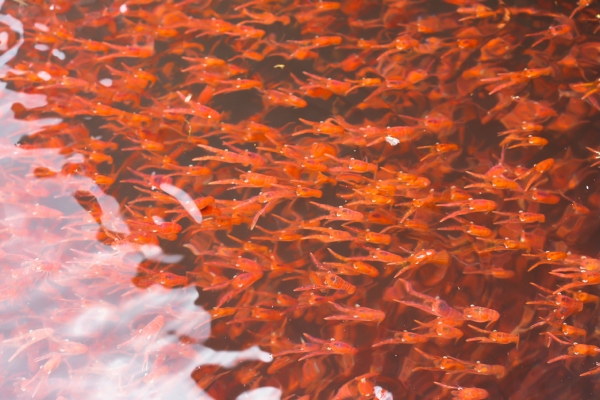All About Krill
These small but mighty crustaceans are way more than whale food

Until recently, my knowledge of krill has been limited to the fact that they’re the primary diet for some of the more charismatic ocean critters like penguins, seals and baleen whales. But these tiny planktonic crustaceans are so much more than just whale food!
Norwegian for “small fry of fish” (I know—not a great start), these transparent-bodied crustaceans average about two inches in length and are found in large swarms which help protect them against predators. These swarms can be as large as 30,000 individual krill per cubic meter! Who are you calling “small fry”?
Another way krill attempt to avoid predation is with critical nightly migrations known as diurnal vertical migrations. In short, krill come to the ocean surface at night to feed on nutrient-dense phytoplankton and migrate back to the ocean depths during the day. Some krill species will even make this trip multiple times a night.
Did you know that blue whales feed almost exclusively on krill? In fact, a blue whale can eat up to four tons of krill in a single day. You might wonder then how krill retain such abundant numbers. Krill can lay up to 10,000 eggs at a time! These eggs hatch about 1,000 meters below the surface, and these little krill babies almost immediately make their journeys to the surface for their first meal of that yummy phytoplankton.
Krill are found almost everywhere—there are more than 85 species of krill throughout the world. However, Antarctic krill (Euphausia superba) are extra special. They are considered a keystone species in the Southern Ocean, which means that the entire ecosystem in the Southern Ocean depends on the Antarctic krill to maintain their way of life. This is partially due to how they redistribute nutrients. Remember those nightly migrations? Antarctic krill feed on the ice algae at the ocean surface and redistribute those nutrients (like iron) in their feces on their way back down, fertilizing the ocean and feeding other ocean critters as they go. They also supply the higher-order predators with phytoplankton and other nutrients once they’re eaten.
They may be on the bottom of the food chain, but krill are still among the most abundant species on the planet. One might say, they’re krillin’ it.

Unfortunately, even krill populations are impacted by climate change. Krill eggs are sensitive to ocean acidification, and Antarctic krill are threatened by a decrease in sea ice. Changes in sea ice could decrease krill habitat by 80% by 2100, which would have massive implications for the rest of the Antarctic food web. Less sea ice = less ice algae = less krill.
Want to help krill and other ocean animals? Learn more about how Ocean Conservancy is tackling climate change and take action with us to urge Congress to invest in ocean climate action.